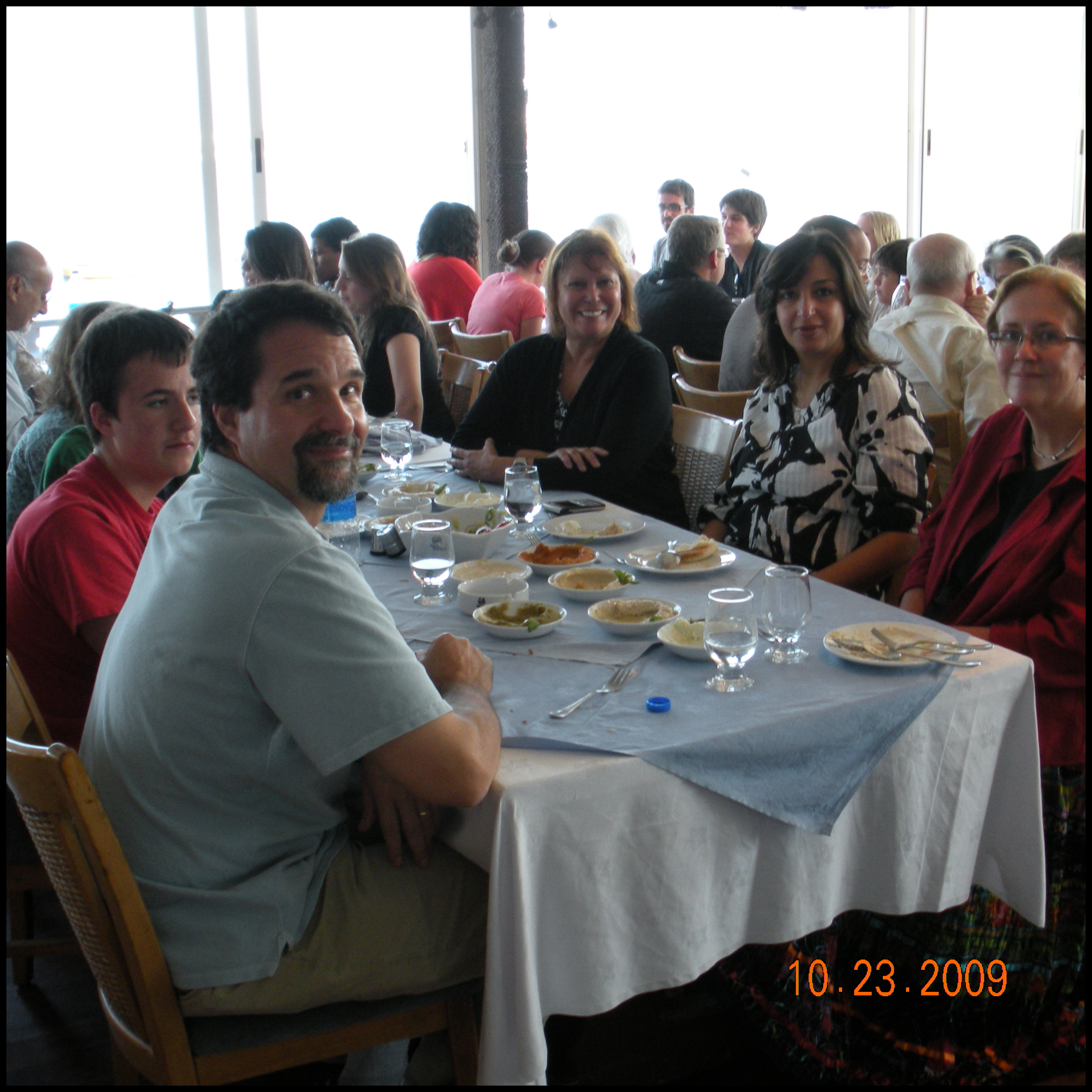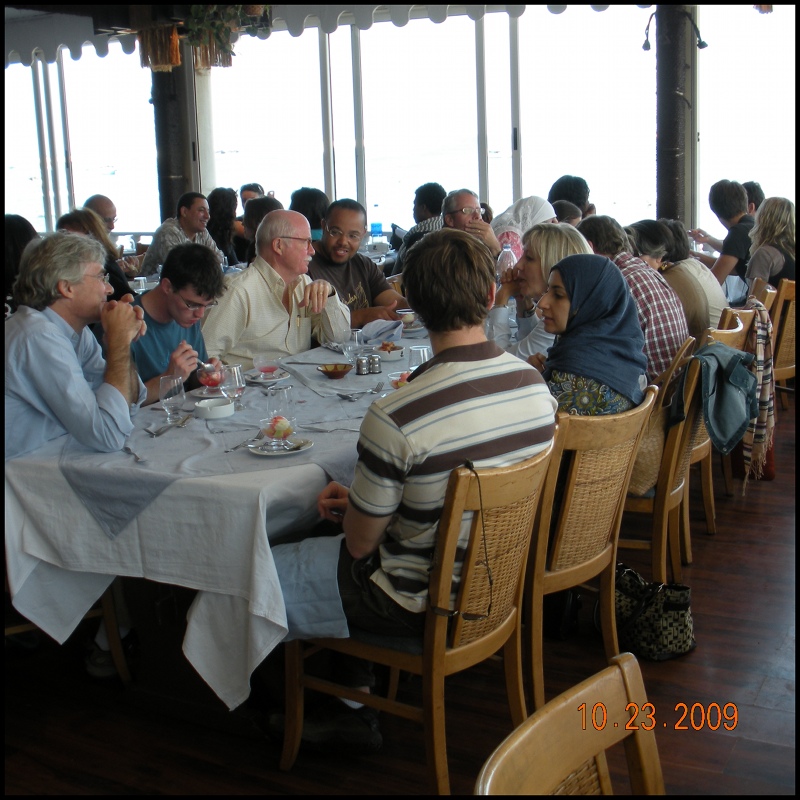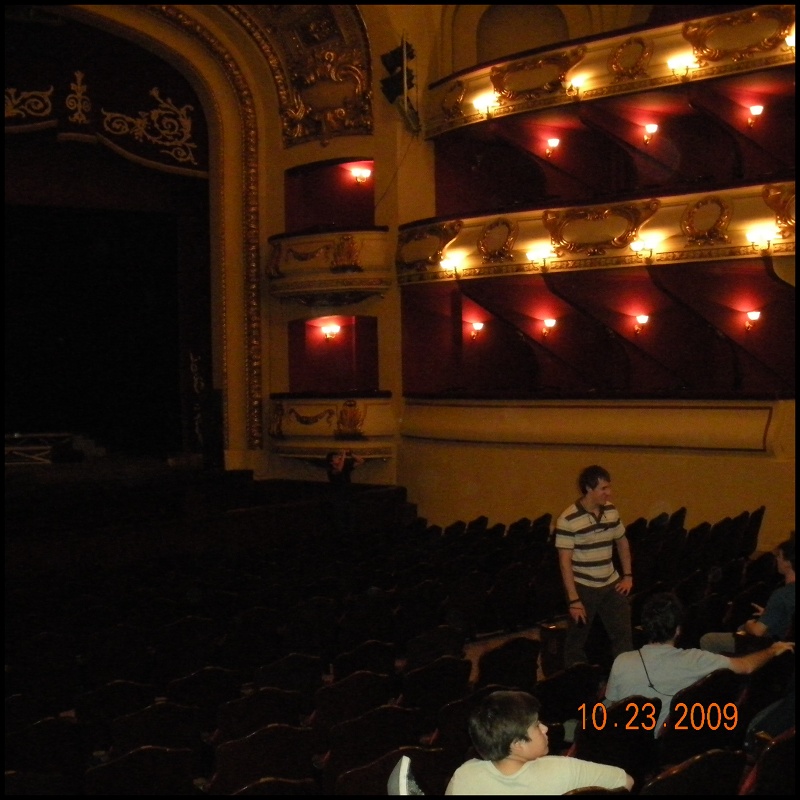Sunday, 25 October 2009
Last week drew to a pleasant close with the arrival on Friday of twenty-two or so Fulbrighters from Cairo who were on a two-day tour of Alexandria. I had been looking forward to seeing my colleagues and was waiting for their bus outside the Fish Market Restaurant, on the waterfront in the district of Alexandria known as al-Anfushy. I had not been to this part of town before and was struck by the differences between this area and others I had seen. Al-Anfushy is one of three or four districts that occupy Alexandria’s most prominent geographical feature, a peninsula that reaches straight out into the Mediterranean. The peninsula roughly resembles a capital “T,” the arms of which on either side of the vertical line bow slightly upward in the middle. This is feature divides the harbor at Alexandria into two separate harbors. The harbor to the West is the commercial port; the one to the East, where I was standing, was for small fishing boats and pleasure craft. There are also beaches here.
Just to my left, not a half mile to the North, was the location of the famous Greek lighthouse known as the Pharos, whose site was now occupied by the fortress built by Mamluk Sultan Qayt Bey in the 1480’s. Across the water to the west lies a much narrower peninsula which embraces the waters of the harbor from that side. That peninsula was originally a causeway built by the founders of the city in the 4th century BC. Over time, it has silted up and now forms an unbroken link with the mainland. The city, with the spectacular slanted disc of the Bibliotheca in the middle foreground, stretches away to the West along the coast. This is the high rent district and it shows distinct influences of the various European communities who have lived here over the past two centuries. Buildings of four to six stories with classical architectural features look out over the water, fronting on the broad Corniche. There are also several large mosques here, surrounded by gardens, masonry walls and ornate iron gates. The street level space in virtually every one of these buildings is a coffee shop, with wicker or wrought iron chairs and tables lining the sidewalks.
The parking lot of the restaurant where we were to eat lunch had a row of red plastic traffic cones lined up along one side and I assumed that the guarded space was for the Fulbright bus. I knew that their arrival time was only approximate and thought that perhaps they had already arrived so I wandered toward the restaurant, which was one of several shoehorned into a space between the Corniche and the sea. To my right, a building of two stories blocked my view of the harbor. The structure seemed to hold at least two eateries. After passing through a couple of archways, I emerged on a plaza where a large group of men was just dispersing after their noon prayers. I thought, “What a lovely place for a service.” I wandered down the length of the esplanade, looking in restaurant windows on both the first and second floors for familiar faces. Seeing none, I returned to the street and stood beneath one of the palms lining that stretch of the road.
After about five minutes, a big sleek tour bus pulled up and disgorged the Cairo Fulbright contingent. Hearty greetings were exchanged and Noha, one of the Fulbright staff handed me my passport (I had surrendered it to her when I was last in Cairo so my residency visa could be processed by the Egyptian government). I was glad to have it back. Noha and the other members of the Cairo office then led us up a set of stairs in the building I had passed by earlier where a large open room holding numerous tables lay before us. We were guided to two long tables and seated ourselves according to individual whim and a degree of chance. Mezze (Middle Eastern antipasto) in its various guises appeared, together with baskets of fresh pita bread. Between bites of food, conversations blossomed; I caught up on what people were doing in Cairo and how their teaching and research projects were progressing. Many people expressed excitement about touring the Bibliotheca on Saturday. Once the remnants of the mezze were cleared, the main course was served: shrimp and baked fish with a side of spiced rice. Just the sort of meal one needed for a busy afternoon of sightseeing.

We spent a pleasant hour or so eating and enjoying the view across the bay. Then, we boarded the bus and made the short drive to Sa`d Zaghloul Square, where accommodations in the Sofitel Cecil had been arranged for the group. One of the Fulbright staff had already secured room keys and these were distributed as we rode along. (I had my own place, of course) After everyone checked in and had a bit of a rest, the group reassembled in a second floor conference room where Ms. Nadia Fanous, an Alexandrian personage of some standing whose family has a long history here, was introduced as our guide for the rest of the day. She gave us a brief overview of the history of the part of Alexandria we were going to see and then led us downstairs.Out on the street, we crossed the busy thoroughfare of the “downtown” section, playing tag with waves of vehicles. Ms. Fanous pointed out the European style architecture, the (now much diminished) financial district and one or two famous landmark buildings.
Passing along to a narrower street, we turned right and entered an enclosed garden in the middle of which stood Alexandria’s synagogue, a structure erected in the late nineteenth century when the Jewish community numbered in the tens of thousands. A magnificent building with Victorian influences apparent, Italian pink granite columns, Corinthian style capitals, stone balustrades along the upper gallery. The man who spoke to us about the building is the synagogue’s custodian and one of four Jewish males still living in Alexandria. At sixty-two, he is the youngest. The remaining twenty are all elderly women. To be able to convene a minyan (requiring ten adult Jewish males), the community relies on the sons and grandsons of the community’s women, even though those men may profess another religion. When the community disappears, the building will become a museum. When this prospect was brought to the attention of the caretaker, he pursed his lips and shrugged. “It’s God’s will,” he said.
After looking around the interior, we went out a side door into a courtyard on the east side of which stood the Jewish School, a four-story building with an inscription on the side in Arabic identifying it as such. The garden was filled with various trees and shrubs planted in brick lined beds. Canals for watering were laid out between some of them.
We exited the precinct, thanking our guide and boarded our bus, which stood waiting for us.
Our next stop was the Coptic Cathedral of Saint Mark. This had been the seat of the Coptic Popes for centuries and all of their remains are interred in a crypt beneath the building. Removing our shoes, we descended and viewed the final resting place of the church’s highest ranking servants, a low chamber with a plexiglass front through which one saw mostly dust. A couple of the faithful were writing prayers on scraps of paper which they then pushed into the crypt through a small hole in the plastic window. Our next stop was the newly renovated Alexandrian Opera House. We were greeted by Hoda Abboud, the institution’s public relations manager. She gave us a tour of the performance space, extolling its acoustics and the clear sight lines of almost all of its 700 seats. She also showed us a ballet practice space and the loge and balcony levels. Quite a nice theater and more evidence of the effort to re-mold Alexandria as a cultural, educational and commercial showcase.
Another stop was the city’s cultural center where citizens were exposed to various art forms through exhibitions, children’s and adult art classes, concerts and the like. There was a quite spectacular exhibition of modern Japanese ceramics in place when we visited, with some astonishingly breathtaking work by masters from different geographic locations in that country. A guitar master class had just taken place in the performance space that afternoon. The building was once called the Muhammad Ali Club and was an exclusive retreat for the city’s nineteenth and early twentieth century elite.
From here, back on the bus for a quick tour of the `Attareen (perfume makers) district which today is home to scores of furniture shops that turn out ready-made antiques. French Empire furniture still holds a sizable market share in Egypt and there were tons of it here. Street after street of small, one- or two-room shops with half finished chairs, breakfronts, wardrobes, and sofas standing on the narrow sidewalks. Even now, with daylight quickly fading, the work continued unabated. We drove past the Roman theatre ruins, but were unable to see very much of it in the twilight.
This was undoubtedly the least pleasant part of the tour, for me, at least, riding through a working class district in a huge, flashy tour bus. It was uncomfortable not in a physical sense, but rather because it emphasized our position of privilege in relation to the inhabitants. We gawked through the windows; the residents gawked back. And gestured. I realize that we would be perceived as privileged by the locals even if we were touring on foot, but the distance created by the bus’s walls and windows only enhanced the sense of removal from the reality of these people’s everyday lives—on which we were intruding in a very high profile manner. We were now hurrying to dinner, reservations for which had been made at Santa Lucia, an upscale restaurant behind the hotel where the group was staying. Dinner was veal scallopine, served with a green salad and rice and broccoli as sides. Chocolate mousse topped off the meal.
After dinner, most people chose to walk back to the hotel so smaller groups broke off from the main one and wandered up over a slight rise toward the ocean. The street along which we walked was filled with people, mostly young men but many women as well. For the first time since I arrived, I was witness to the sort of harassment that women (particularly, but not exclusively, young western women) have to endure here. My presence among a number such women seemed to aggravate the situation. Testosterone fueled adolescent fantasies were no doubt being exchanged among these guys. Although I was unable to actually comprehend any of the comments being tossed our way, the tenor of the words was easily understood. That gauntlet was run without incident, however, and we emerged on Sa`d Zaghloul Square and entered the hotel.
In the foyer, we were greeted by a band of men playing drums and a trumpet and singing in a celebratory fashion. The reason for this was quickly apparent for at the foot of the staircase surrounded by the drummers and singers, was a newly wedded pair. Women in the wedding party suddenly let fly with their characteristic sound of joy, the ululation, which I can’t describe in words and can only very poorly imitate. You will thank me for not ever trying to imitate it, trust me.
The party processed past the front door and moved off in the direction of the reception room; our presence was apparently not viewed as an intrusion; we simply joined in as another group of celebrants. Once the procession passed by, some of the Fulbrighters decided to retire to “Monty’s Bar” a watering hole on the hotel’s second floor. Monty’s is named in honor of Field Marshal Bernard Montgomery, the British World War Two general who fought against Germany’s famous “Desert Fox,” General Erwin Rommel. Monty apparently ran his North Africa campaign from this hotel. I did not check the veracity of this story, but Monty’s photo was prominently displayed on one wall. In any case, we rounded out the evening with a glass of whatever and then made our separate ways off to bed. My road lay along the Corniche, so I hailed a cab and went home.
Saturday morning, I met the group at the Bibliotheca, where we were treated to an extensive and quite whirlwind tour not only of the library (which everyone judged to be a magnificent building), but of most of its ancillary units as well. We saw the museum devoted to Shadi Abdel Salam, a famous Egyptian film director, philosopher, and designer. It was he who designed Cleopatra’s ship for Joseph Mankiewicz’s 1962 film “Cleopatra” which starred Elizabeth Taylor and Richard Burton. Next stop was a space called the Culturama, which featured another interactive display on nine projection screens, the same system we had experienced at the University of Cairo’s Central Library last week. This program gave an overview of Egypt’s history in visual form, complete with virtual tours of some of the more famous historical sites, such as the temple at Luxor. Next we visited a small museum devoted to the life of former Egyptian President Anwar Sadat. The exhibit even included the bloody, bullet torn military tunic he was wearing when he was assassinated. Our final stop was the antiquities museum, which contains numerous artifacts relating to Egypt’s—and particularly Alexandria’s—history. Many of the items on display were uncovered during the excavation of the library’s construction site.
Again, we were pressed for time, so we hurried to the bus for our final stop, lunch at the Greek Club, which is located near the end of the peninsula that forms part of the harbor. We sat on a second floor terrace and ate lunch with a group of Egyptian Fulbright alumni.
I sat at a table with several students, Bruce Lohof, the director of the Cairo Fulbright office, and two faculty/administrators from the University of Alexandria. Ismail Gomaa is a professor of environmental geology and Muhammad Ibrahim is Vice Dean for Community Development and Environmental Affairs. He is also a professor in the business school. Both men had held Fulbright teaching fellowships in the United States. We enjoyed our meal and lively conversation about Egypt’s development, the Egyptians’ Fulbright experiences and the state of the world in general.
All too soon, the time for departure arrived and we strolled out onto the sea wall for a group photo before taking or leave. The group boarded the bus and I hailed a cab for the ride back to my apartment. Tomorrow, it’s back to work.



